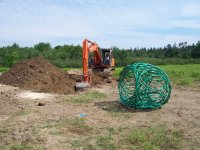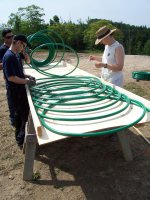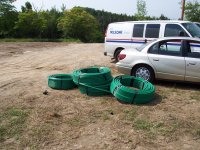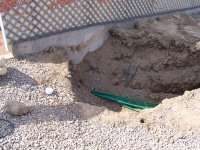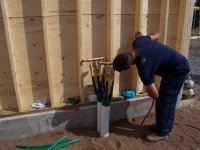boggen
Elite Member
- Joined
- Feb 22, 2011
- Messages
- 3,829
- Location
- Trivoli, IL
- Tractor
- SSTT (Sideways Snake Tain Tractor) and STB (sideways train box) tractor, dirt harvester
i have looked into closed pond loop, well closed loop where pipes are further in cased in concrete and other material.
all the piping / hose = a large DIY heat exchanger with ground and/or water.
for ponds. i would have second thoughts more so if there are fish in it. and if pond is shallow = bigger problem. during winter. the pond bottom is warmer, while surface water = colder. and in summer pond bottom is colder, while surface water is warmer.
when folks say 15' deep i can honestly believe that would be needed. so as not to kill the fish out, yet still have a functioning loop setup. or rather i should say, have more healthy fish due to them not freezing to death, or per say sweating to death and being deep fried.
its not about pond freezing solid or boiling. but the extra degrees warmer or cooler that could make difference to the fish. and having a healthy fish population.
as far as heating and cooling go for your house on other hand. that is a different story.
======================
knowing how fishing goes, with anchors, lures, stuff being dropped into lake / pond by accident. if it were me, i would be more likely to put at least some dirt over a pond loop setup. mainly to protect it. both from humans, but also wildlife from turning over a pipe and getting it into a bind with a kink in it.
some things that do catch me eye, are these long loops, getting placed deep, but then the last 100 feet or so to house. end up being buried rather shallow. and it doesn't make sense to me. due to potential heat loss / cooling loss.
and on another note, is pipe sizing. is another thing on these long loops. i can understand cost side vs going with a little bigger size pipe. but paying for a bigger size horse power pump to push water through the system.
and for the horizontal loops. i can understand reason for how they criss cross the loops as they lay them down into the trenches. but at times i wonder. if paying for a longer trench and use same amount of pipe but just stretching the criss crossing of the pipes out further might have a better longer effect.
with closed loop vs open loop setups. i think i would prefer to go with a closed loop, and and a little bit of antifreeze (not sure correct naming is) to possibly obtain better heat capacity being absorbed in the loops (perhaps the old thinker, has forgtten things and mixed up some mumbo jumbo).
my only concern about the antifreeze is loops were placed into a pond that didn't have any dirt over them. but just sunk to the bottom of the lake.
on another note: the loops for ponds were they just sank to the bottom. and a few coils are fastened directly together. seems like a cheap way to do things, but i would think you would also loose capacity. and require more length of hose. vs if you drained the pond/lake down. and did something like horizontal runs do. with the criss crossing of the loops. or perhaps using rebar to fasten the loops so the criss crossing of the loops are further apart per loop.
all the piping / hose = a large DIY heat exchanger with ground and/or water.
for ponds. i would have second thoughts more so if there are fish in it. and if pond is shallow = bigger problem. during winter. the pond bottom is warmer, while surface water = colder. and in summer pond bottom is colder, while surface water is warmer.
when folks say 15' deep i can honestly believe that would be needed. so as not to kill the fish out, yet still have a functioning loop setup. or rather i should say, have more healthy fish due to them not freezing to death, or per say sweating to death and being deep fried.
its not about pond freezing solid or boiling. but the extra degrees warmer or cooler that could make difference to the fish. and having a healthy fish population.
as far as heating and cooling go for your house on other hand. that is a different story.
======================
knowing how fishing goes, with anchors, lures, stuff being dropped into lake / pond by accident. if it were me, i would be more likely to put at least some dirt over a pond loop setup. mainly to protect it. both from humans, but also wildlife from turning over a pipe and getting it into a bind with a kink in it.
some things that do catch me eye, are these long loops, getting placed deep, but then the last 100 feet or so to house. end up being buried rather shallow. and it doesn't make sense to me. due to potential heat loss / cooling loss.
and on another note, is pipe sizing. is another thing on these long loops. i can understand cost side vs going with a little bigger size pipe. but paying for a bigger size horse power pump to push water through the system.
and for the horizontal loops. i can understand reason for how they criss cross the loops as they lay them down into the trenches. but at times i wonder. if paying for a longer trench and use same amount of pipe but just stretching the criss crossing of the pipes out further might have a better longer effect.
with closed loop vs open loop setups. i think i would prefer to go with a closed loop, and and a little bit of antifreeze (not sure correct naming is) to possibly obtain better heat capacity being absorbed in the loops (perhaps the old thinker, has forgtten things and mixed up some mumbo jumbo).
my only concern about the antifreeze is loops were placed into a pond that didn't have any dirt over them. but just sunk to the bottom of the lake.
on another note: the loops for ponds were they just sank to the bottom. and a few coils are fastened directly together. seems like a cheap way to do things, but i would think you would also loose capacity. and require more length of hose. vs if you drained the pond/lake down. and did something like horizontal runs do. with the criss crossing of the loops. or perhaps using rebar to fasten the loops so the criss crossing of the loops are further apart per loop.
